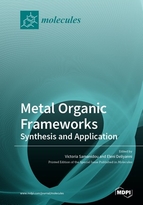Metal Organic Frameworks: Synthesis and Application
A special issue of Molecules (ISSN 1420-3049).
Deadline for manuscript submissions: closed (15 September 2019) | Viewed by 77418
Special Issue Editors
Interests: analytical chemistry; sample preparation; chromatography; HPLC; method validation; method development; separation science; food analysis; bioanalysis; environmental analysis; green analytical chemistry; sorptive extraction; microextraction techniques
Special Issues, Collections and Topics in MDPI journals
Interests: materials chemistry; materials characterization; nanomaterials; graphene oxide; activated carbon; wastewater treatment; separation; adsorption; catalytic oxidation; environmental applications
Special Issues, Collections and Topics in MDPI journals
Special Issue Information
Dear Colleagues,
Metal–organic frameworks (MOFs) are among the most promising novel materials. These belong to a new class of crystalline materials that consist of coordination bond between metal clusters (e.g., metal-carboxylate clusters and metal-azolate clusters), metal atoms, or rod-shaped clusters and multidentate organic linkers that contain oxygen or nitrogen donors (like carboxylates, azoles, nitriles, etc.), thus, a three-dimensional structure is formed.
The properties of both metal ions and linkers determine the physical properties of MOFs networks (e.g., porosity, pore size, and pore surface). Additionally, the structural properties of the prepared frameworks can be controlled by the solvent system, pH, metal-ligand ratio, and temperature.
The concept of MOFs was first introduced in 1990. They were actually initially used in catalysis, gas separation, membranes, electrochemical sensors. Later on, they were introduced as SPE (Solid Phase Extraction) sorbents for PAHs (Polycyclic Aromatic Hydrocarbons) in environmental water samples, then the range expanded to the field of analytical chemistry, both in chromatographic separation and sample preparation, with great success in, e.g., SPE and SPME (Solid Phase Mico-extraction). Since then, the number of analytical applications implementing MOFs as sorbents in sorptive sample preparation approaches is increasing. Τhis is reinforced by the fact that, at least theoretically, an infinite number of structures can be designed and synthesized, thus making tuneability one of the most unique characteristics of MOF materials. Moreover, they have been designed in various shapes, such as columns, fibers, and films, so that they can meet more analytical challenges with improved analytical features.
Their exceptional properties attracted the interest of analytical chemists who have taken advantage of the unique structures and properties and have already introduced them in several sample pretreatment techniques, such as solid phase extraction, dispersive SPE, magnetic solid phase extraction, solid phase microextraction, stir bar sorptive extraction, etc.
This Special Issue aims to present the recent developmentts in the synthesis and applications of MOFs.
Prof. Dr. Victoria F. Samanidou
Prof. Dr. Eleni Deliyanni
Guest Editors
Manuscript Submission Information
Manuscripts should be submitted online at www.mdpi.com by registering and logging in to this website. Once you are registered, click here to go to the submission form. Manuscripts can be submitted until the deadline. All submissions that pass pre-check are peer-reviewed. Accepted papers will be published continuously in the journal (as soon as accepted) and will be listed together on the special issue website. Research articles, review articles as well as short communications are invited. For planned papers, a title and short abstract (about 100 words) can be sent to the Editorial Office for announcement on this website.
Submitted manuscripts should not have been published previously, nor be under consideration for publication elsewhere (except conference proceedings papers). All manuscripts are thoroughly refereed through a single-blind peer-review process. A guide for authors and other relevant information for submission of manuscripts is available on the Instructions for Authors page. Molecules is an international peer-reviewed open access semimonthly journal published by MDPI.
Please visit the Instructions for Authors page before submitting a manuscript. The Article Processing Charge (APC) for publication in this open access journal is 2700 CHF (Swiss Francs). Submitted papers should be well formatted and use good English. Authors may use MDPI's English editing service prior to publication or during author revisions.
Keywords
- metal organic framework
- catalysis
- sample preparation
- sensors
- gas extraction
- sorptive extraction
Related Special Issue
- Metal Organic Frameworks: Synthesis and Application II in Molecules (9 articles)








